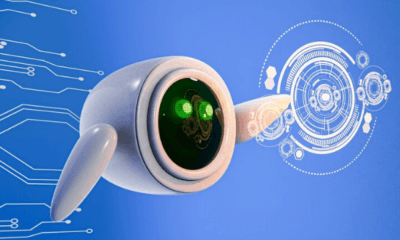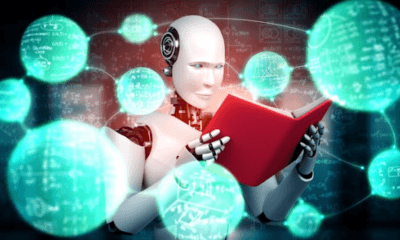tech
Nvidia Neuromorphic Chip: Advancing AI Technology

Businessreign – Hello, dear readers! How are you? Welcome to this exciting article where we delve into the revolutionary world of artificial intelligence. Today, we have an extraordinary development to share with you: the Nvidia Neuromorphic Chip. This groundbreaking innovation is poised to advance the very foundation of AI technology, bringing us closer to a future where machines can truly think and learn like humans. So, without further ado, let’s explore the incredible capabilities of this chip and discover how it promises to shape the future of AI. Greetings and please continue reading.
Introduction to Neuromorphic Computing
Introduction to Neuromorphic Computing is a fascinating field that combines neuroscience and computer science to develop computing systems inspired by the human brain. These systems aim to mimic the brain’s structure and functionality, enabling them to perform complex tasks efficiently.
Neuromorphic computing utilizes artificial neural networks and specialized hardware to create intelligent systems capable of processing vast amounts of data in parallel. These systems have the potential to revolutionize various industries, including healthcare, robotics, and artificial intelligence.
By leveraging the brain’s remarkable abilities, neuromorphic computing opens up new possibilities for solving complex problems and advancing our understanding of intelligence. As researchers continue to explore this field, we can expect to see significant advancements in computing technology that will shape the future of AI and machine learning.
Key Features of Nvidia’s Neuromorphic Chip
Nvidia’s Neuromorphic Chip offers groundbreaking features that revolutionize artificial intelligence and computing. This innovative chip mimics the human brain’s neural network, enabling it to process and analyze data with unprecedented efficiency.
The chip’s key features include ultra-low power consumption, making it ideal for edge computing and IoT devices. Additionally, it boasts exceptional adaptability, allowing it to learn from and respond to real-time data inputs.
The chip’s parallel processing capabilities enable it to handle complex tasks such as pattern recognition and sensor data analysis with remarkable speed and accuracy. Moreover, its neural architecture facilitates advanced AI applications like autonomous vehicles and robotics.
With Nvidia’s Neuromorphic Chip, the future of computing is set to be more intelligent, energy-efficient, and versatile.
Applications of Neuromorphic Technology in AI
Neuromorphic technology has emerged as a fascinating area of research within the field of artificial intelligence (AI). This innovative approach aims to mimic the structure and functionality of the human brain in designing intelligent systems.
By leveraging the power of neuromorphic computing, AI applications can potentially achieve greater efficiency, flexibility, and adaptability.One of the key applications of neuromorphic technology in AI is in the field of robotics.
Neuromorphic systems can enable robots to perceive and interact with their environment in a more human-like manner. By incorporating neuromorphic chips into the robot’s architecture, it becomes possible to process sensory information in real-time, enabling the robot to make decisions and navigate its surroundings more effectively.
Another area where neuromorphic technology shows promise is in the field of image and speech recognition. Traditional AI algorithms often struggle to accurately identify and interpret complex visual or auditory data.
However, by utilizing neuromorphic computing, AI systems can better handle these tasks by emulating the parallel processing capabilities of the human brain. This can lead to improved accuracy and faster processing times in tasks such as facial recognition, object detection, and natural language processing.
Neuromorphic technology also holds potential in the realm of cognitive computing. By simulating the intricate neural networks of the human brain, AI systems can develop a deeper understanding of complex patterns and relationships in data.
This can be particularly beneficial in areas such as data analytics, where large volumes of information need to be processed and analyzed to extract meaningful insights.Furthermore, neuromorphic technology has the potential to revolutionize the field of neuromedicine.
By creating artificial neural networks that closely resemble the structure and function of the human brain, researchers can gain a better understanding of neurological disorders and develop more effective treatments.
This could lead to significant advancements in areas such as neurorehabilitation, brain-computer interfaces, and personalized medicine.In summary, the applications of neuromorphic technology in AI are vast and diverse.
From robotics to image recognition, cognitive computing to neuromedicine, this emerging field has the potential to transform the way we approach and solve complex problems. As researchers continue to explore and refine this technology, we can expect to see even greater advancements in the coming years.
Advantages of Neuromorphic Chips in AI Development
Neuromorphic chips have emerged as a groundbreaking technology in the field of artificial intelligence (AI) development. These chips are designed to mimic the structure and functionality of the human brain, enabling them to process information in a highly efficient and parallel manner.
One of the key advantages of neuromorphic chips is their ability to perform complex computations with extremely low power consumption. This makes them ideal for applications that require real-time processing, such as autonomous vehicles and robotics.
Furthermore, neuromorphic chips offer significant advantages in terms of speed and scalability, allowing for the development of more advanced and sophisticated AI systems. With their unique architecture and capabilities, neuromorphic chips are poised to revolutionize the field of AI and drive innovation in various industries.
Challenges and Limitations of Neuromorphic Computing
Neuromorphic computing presents promising opportunities for advancing artificial intelligence, but it also comes with challenges and limitations. One key challenge is the development of hardware that can accurately mimic the complexity and efficiency of the human brain.
Current neuromorphic systems still struggle to match the brain’s energy efficiency and computational power. Additionally, designing algorithms that can effectively leverage the capabilities of neuromorphic hardware remains a hurdle.
The lack of stKamurdized software tools and programming languages further complicates the widespread adoption of neuromorphic computing. Moreover, ethical considerations related to privacy, security, and the potential misuse of neuromorphic technologies demand careful attention.
Addressing these challenges will require interdisciplinary collaboration and sustained research efforts to fully harness the potential of neuromorphic computing while mitigating its limitations.
Comparison with Traditional AI Hardware
Traditional AI hardware, such as CPUs and GPUs, has long been the backbone of machine learning and AI applications. However, with the increasing demand for more powerful and efficient AI processing, specialized hardware like TPUs and AI accelerators have emerged as viable alternatives.
While traditional hardware is versatile and widely available, these new solutions offer significant performance improvements and power efficiency, making them ideal for large-scale AI workloads. Additionally, specialized AI hardware is designed to handle the specific computational requirements of deep learning and neural network models, leading to faster training and inference times.
As AI continues to advance, the shift towards specialized AI hardware signifies a pivotal evolution in the field of artificial intelligence.
Neuromorphic Chip’s Impact on Machine Learning Algorithms
Neuromorphic chips have revolutionized the field of machine learning algorithms. These specialized chips, inspired by the structure and function of the human brain, offer unprecedented processing power and efficiency.
By mimicking the parallel processing capabilities of the brain, neuromorphic chips enable faster and more accurate computations, leading to significant advancements in various applications such as computer vision, natural language processing, and robotics.
With their ability to process vast amounts of data in real-time, these chips have the potential to unlock new possibilities in artificial intelligence and reshape the future of technology. As researchers continue to explore and refine neuromorphic chip designs, we can expect even greater breakthroughs in machine learning algorithms.
Neuromorphic Computing in Edge Devices
Neuromorphic computing in edge devices involves the development of hardware and software that mimic the neurobiological architectures of the human brain. This cutting-edge technology aims to enable edge devices to perform complex cognitive tasks with high efficiency and low power consumption.
By leveraging principles of neural networks and synaptic connections, neuromorphic computing holds the potential to revolutionize edge computing by enabling devices to process and analyze data in real time, making them capable of autonomous decision-making and learning.
With the integration of neuromorphic computing in edge devices, we can expect significant advancements in fields such as autonomous vehicles, IoT devices, and personalized healthcare, ultimately leading to a more intelligent and responsive network of connected devices.
Nvidia’s Role in Advancing Neuromorphic Technology
Nvidia has been at the forefront of advancing neuromorphic technology, revolutionizing the field with its cutting-edge innovations. With their expertise in artificial intelligence and deep learning, Nvidia has successfully developed high-performance GPUs that mimic the functionality of the human brain.
These neuromorphic processors are designed to process vast amounts of data in parallel, enabling faster and more efficient computing. By harnessing the power of neuromorphic technology, Nvidia has paved the way for groundbreaking applications in various fields, including robotics, healthcare, and autonomous vehicles.
With their commitment to pushing the boundaries of what’s possible, Nvidia continues to play a pivotal role in shaping the future of neuromorphic technology and unlocking its full potential.
Future Possibilities with Neuromorphic AI
Artificial Intelligence (AI) has revolutionized the way we live and work, and its potential seems limitless. One exciting development in the field is Neuromorphic AI, which aims to mimic the functioning of the human brain.
This cutting-edge technology holds great promise for the future, offering a wide range of possibilities.Neuromorphic AI has the potential to significantly improve various industries. For instance, in healthcare, it could revolutionize medical diagnosis and treatment by analyzing vast amounts of patient data with incredible speed and accuracy.
This could lead to earlier detection of diseases and more personalized treatment plans.Another area where Neuromorphic AI could have a profound impact is in transportation. With its ability to process massive amounts of data in real-time, it could enhance autonomous vehicles, making them safer and more efficient.
These vehicles could adapt to changing road conditions, predict potential hazards, and communicate with each other to optimize traffic flow.In the field of education, Neuromorphic AI could transform the way we learn.
By personalizing the learning experience based on individual strengths and weaknesses, it could help students grasp complex concepts more easily. Adaptive learning systems could tailor educational content to suit each student’s unique needs, leading to improved academic outcomes.
Neuromorphic AI also has the potential to revolutionize the way we interact with technology. Natural language processing and emotion recognition capabilities could enable more intuitive and human-like interactions with virtual assistants, making them more responsive and empathetic.
This could enhance user experiences in various domains, from customer service to entertainment.However, as with any emerging technology, there are challenges that need to be addressed. Ensuring the ethical use of Neuromorphic AI is crucial, as it raises concerns about privacy, security, and bias.
Striking the right balance between technological advancements and ethical considerations will be essential in shaping the future of Neuromorphic AI.In conclusion, the future possibilities with Neuromorphic AI are vast and exciting.
From transforming healthcare and transportation to revolutionizing education and human-computer interactions, this technology has the potential to reshape various aspects of our lives. As we continue to explore its capabilities and address the associated challenges, Neuromorphic AI holds great promise for a future that is more intelligent and interconnected.
FOR MORE DETAILS WATCH THIS VIDEO
About The Author

Business
HTTPS Business Google com Locations GMBsrc WW WW OT GS Z GMB LZH Z OGB U – A Breakdown
Businessreign.com
Business and Technology: A Symbiotic Relationship
The relationship between business and technology has always been a symbiotic one. Technology has always been a key enabler of business growth, and businesses have always been a key driver of technological innovation.
In the early days of business, technology was limited to simple tools and machines that could help businesses automate tasks and improve efficiency. As technology has advanced, so too has the role it plays in business. Today, technology is an essential part of every business, from the smallest startup to the largest corporation.
Technology can help businesses in a variety of ways. It can help them to:
- Automate tasks: Technology can automate many of the tasks that were once done manually, freeing up employees to focus on more strategic and creative work.
- Improve efficiency: Technology can help businesses to improve their efficiency by streamlining processes and reducing errors.
- Reach new customers: Technology can help businesses to reach new customers through online marketing and social media.
- Gain insights: Technology can help businesses to gain insights into their customers and markets through data analytics.
- Innovate: Technology can help businesses to innovate by providing them with new tools and platforms to experiment with new ideas.
The benefits of technology for businesses are clear. However, it is important to remember that technology is not a magic bullet. It is important to use technology in a strategic way that aligns with the business’s goals.
The Future of Business and Technology
The relationship between business and technology is only going to become more important in the future. As technology continues to advance, it will create new opportunities for businesses to grow and innovate.
Some of the key trends that will shape the future of business and technology include:
- The rise of artificial intelligence: Artificial intelligence (AI) is already having a major impact on businesses, and this impact is only going to grow in the future. AI can be used to automate tasks, improve efficiency, and gain insights into customers and markets.
- The growth of the internet of things: The internet of things (IoT) refers to the network of physical devices that are connected to the internet. The IoT is growing rapidly, and it is creating new opportunities for businesses to collect data and automate tasks.
- The development of 5G: 5G is the next generation of wireless technology. It will offer faster speeds and lower latency, which will open up new possibilities for businesses.
These trends are just the tip of the iceberg. The future of business and technology is full of possibilities, and it is up to businesses to take advantage of them.
Conclusion
The relationship between business and technology is a symbiotic one. Technology has always been a key enabler of business growth, and businesses have always been a key driver of technological innovation.
The future of business and technology is full of possibilities. Businesses that embrace technology and use it in a strategic way will be well-positioned to succeed in the years to come.
Businessreign.com
About The Author
Business
Business Review Presentation – Template PPT Bisnis Aesthetic
Businessreign.com
Business Review Presentation – Aesthetic Business PPT Template
Slide 1: Cover
Title: [Company Name] Business Review – Towards Success Together
Subtitle: “[Year]” (optional)
Image: Use a background image that represents your industry or company.
Speaker Notes:
- Welcome the audience and introduce yourself.
- Give a brief overview of the presentation.
Slide 2: Table of Contents
Title: Table of Contents
Bullet Points:
- Executive Summary
- [Year] Performance Review
- SWOT Analysis
- Strategies and Future Plans
- Q&A
Image: A simple image of a table of contents.
Speaker Notes:
- Briefly explain each section of the presentation.
Slide 3: Executive Summary
Title: Executive Summary
Bullet Points:
- Overview of company performance in [Year]
- Key achievements
- Areas for improvement
Image: A graph or chart showing the company’s financial performance.
Speaker Notes:
- Summarize the company’s performance in the past year.
- Highlight key achievements and areas for improvement.
Slide 4: [Year] Performance Review
Title: [Year] Performance Review
Bullet Points:
- Financial metrics (e.g., revenue, profit, market share)
- Operational metrics (e.g., customer satisfaction, employee productivity)
- Key challenges faced
Image: A graph or chart showing the company’s financial or operational metrics.
Speaker Notes:
- Discuss the company’s financial and operational performance in detail.
- Highlight key challenges faced and how they were addressed.
Slide 5: SWOT Analysis
Title: SWOT Analysis
Bullet Points:
- Strengths
- Weaknesses
- Opportunities
- Threats
Image: A SWOT analysis diagram.
Speaker Notes:
- Discuss the company’s strengths, weaknesses, opportunities, and threats.
- Explain how the company will leverage its strengths and opportunities to overcome its weaknesses and threats.
Slide 6: Strategies and Future Plans
Title: Strategies and Future Plans
Bullet Points:
- Key strategies for the coming year
- Plans for growth and expansion
- Objectives for financial and operational performance
Image: A roadmap or timeline showing the company’s future plans.
Speaker Notes:
- Discuss the company’s strategies and plans for the coming year.
- Explain how the company will achieve its objectives.
Slide 7: Conclusion
Title: Conclusion
Bullet Points:
- Summary of key points
- Vision for the future
- Call to action
Image: A picture of a team working together.
Speaker Notes:
- Summarize the key points of the presentation.
- Share your vision for the company’s future.
- Thank the audience for their time.
Slide 8: Q&A
Title: Q&A
Bullet Points:
- Open the floor for questions
- Answer questions thoughtfully and concisely
Image: A picture of a person answering questions from an audience.
Speaker Notes:
- Answer questions from the audience in a clear and concise manner.
- Thank the audience for their questions.
Additional Tips:
- Use a consistent design theme throughout the presentation.
- Use high-quality images and graphics.
- Keep the text concise and easy to read.
- Practice your presentation beforehand.
By following these tips, you can create a business review presentation that is informative, engaging, and professional.
Businessreign.com
About The Author
Sustainability
Google My Business: Drive Customer Engagement on Google – Boost Your Local Presence
Businessreign.com
Google My Business: Fuel Customer Engagement & Dominate Local Search
In today’s digital world, having a strong online presence is crucial, especially for local businesses. Google My Business (GMB) is a free and powerful tool that helps you manage your online presence on Google Search and Maps. By optimizing your GMB profile, you can attract more customers, boost engagement, and solidify your local dominance.
Here’s how Google My Business can supercharge your local SEO:
- Increased Visibility: A complete and optimized GMB profile increases your chances of appearing in local search results, placing your business right in front of potential customers searching for products or services you offer nearby.
- Enhanced Brand Trust: A well-maintained GMB profile with positive reviews, high-quality photos, and accurate information builds trust and credibility with potential customers.
- Improved Customer Engagement: GMB allows you to directly interact with customers through features like review responses and Q&A sections. This fosters a sense of community and encourages positive interactions.
- Actionable Insights: GMB provides valuable analytics that track customer behavior, such as clicks, calls, and website visits. This data helps you understand your audience better and optimize your profile for maximum impact.
- Free Marketing Opportunities: GMB allows you to showcase special offers, events, and new products directly to local customers. This is a fantastic way to promote your business and drive sales without spending a dime.
Steps to Optimize Your Google My Business Profile:
- Claim and Verify Your Listing: The first step is to claim your existing GMB listing or create a new one if you haven’t already. Google will then send a verification code to confirm ownership.
- Complete Your Business Information: Ensure all your business details are accurate and up-to-date, including your name, address, phone number, website, category, and opening hours. Consistency across platforms is crucial.
- Upload High-Quality Photos: Showcase your business with captivating photos of your storefront, products, team, and work environment. High-quality visuals are essential for grabbing attention and making a positive first impression.
- Encourage Customer Reviews: Positive reviews are gold! Actively encourage satisfied customers to leave reviews on your GMB profile. Respond to all reviews, both positive and negative, in a professional and timely manner.
- Regularly Update Your Profile: Keep your GMB profile fresh by posting updates about new products, services, promotions, and events.
- Utilize GMB Insights: Leverage the data provided by GMB insights to understand how customers are interacting with your profile. Use this information to refine your strategy and optimize your profile for better results.
Bonus Tip: Master the art of responding to reviews! Acknowledge positive feedback with gratitude and address negative reviews professionally. Showcasing your commitment to customer satisfaction strengthens your brand image.
By implementing these strategies, you can transform your Google My Business profile into a powerful tool for attracting new customers, fostering loyalty, and outshining the competition in your local market. Don’t underestimate the power of a well-optimized GMB profile – it’s the key to unlocking local search success!
Businessreign.com
About The Author

 Business9 months ago
Business9 months agoMaster Business Planning: Essential Guide for Aspiring Entrepreneurs

 Business9 months ago
Business9 months agoBusiness Innovation: Top Idea Generation Techniques for Entrepreneurs

 Business9 months ago
Business9 months agoOldest private members’ clubs London: Historical Gems
- AI9 months ago
Should AI Be Banned: Pros, Cons, and the Future of Education

 Business9 months ago
Business9 months agoFamous private clubs in London: Renowned Establishments

 Artificial Intelligence9 months ago
Artificial Intelligence9 months agoArtificial Intelligence Is a Threat to Humanity: Debate Points

 Artificial Intelligence9 months ago
Artificial Intelligence9 months agoIs Artificial Intelligence Good for Society? A Balanced Debate Essay
- AI11 months ago
AI Regulation Impact Assessment Example: A Case Study



